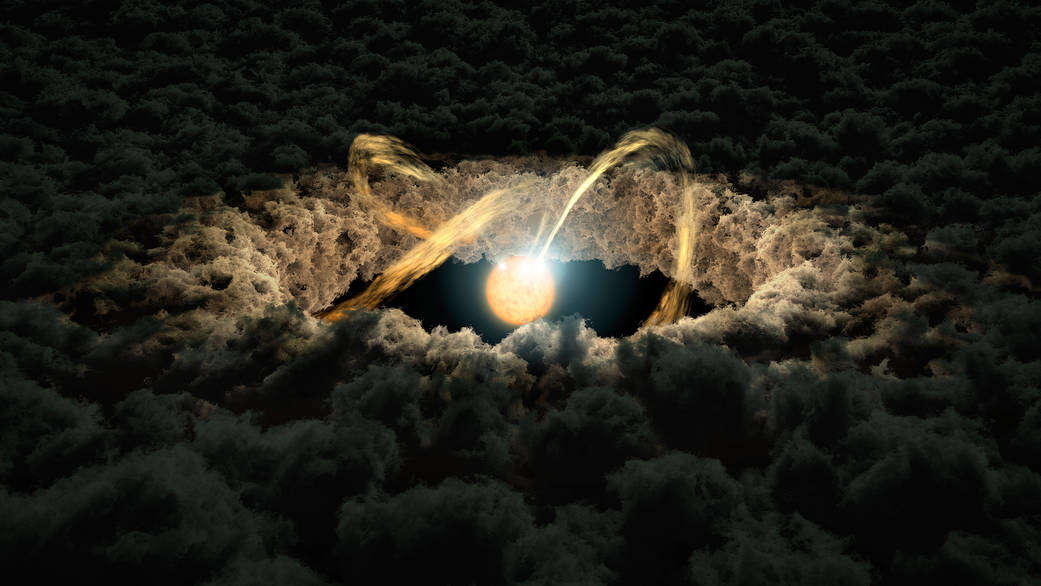Create a free profile to get unlimited access to exclusive videos, sweepstakes, and more!
Alien ingredients? Precursor molecules for life found where planets are born

It seems that every time organics are detected on another planet, the internet explodes, but organic molecules found in planet-forming discs could be the prelude to life.
Whether Earth is the only planet in the entire universe that ever spawned life remains a mystery. Led by astrophysicist John Ilee of the University of Leeds, a team of researchers has looked deep into several protoplanetary discs where planets are born, and recently published a study in The Astrophysical Journal Supplement Series. They found molecules that are the precursors to the larger molecules that directly make up substances such as sugars, amino acids, and RNA. Could these end up as the protoplasm of alien creatures?
The five protoplanetary discs that were observed are between 300 and 500 light-years from Earth, so if we are seeing them as they were hundreds of years ago, it is unlikely that life has materialized yet. Whether these molecules will end up creating the amino acid and RNA molecules that are necessary for life-forms also depends on the conditions over there.
“The molecules we have observed therefore represent the most complex (yet) detected in protoplanetary discs with this bond, and demonstrate that these stages of molecular complexity can be built up in the vicinity of forming planets,” Ilee tells SYFY WIRE. “The carbon-nitrogen bond is a key component of these molecules."
It is that bond which has been proven to be vital to the molecules that make up amino acids. Ilee and his team observed the molecules with the 66 antennas of the Atacama Large Millimetre/submillimetre Array (ALMA), which has an amazing spatial resolution, meaning the precision of things it can see in relation to space. Larger telescopes and arrays have a larger spatial resolution and are able to see more detail as well as smaller and more distant objects. With this equipment, emissions from microscopic molecules became visible.
Because the emissions were so weak, they needed something as powerful as ALMA to seek them out. What was observed by the researchers as part of the Molecules with ALMA at Planet-forming Scales (or MAPS) program were intermediate molecules that are more complex than simple organics, such as carbon monoxide or methane, but not yet complex enough to be the largest molecules that something like RNA can break down into. The problem is that molecules like carbon monoxide give off much stronger emissions. That didn’t stop Ilee from searching.
He obviously found an overflow of molecules, but why so many? It could be that they were hiding in grains of dust that made their way from the outside to the inside of the disc, but there are still questions.
“Increased abundances of these molecules mean we could be missing something in our understanding of how chemistry operates in these environments,” he says. “We could also be missing an important physical process that would increase the abundance of these molecules in the discs.”
The molecules the team set out to find were cyanoacetylene (HC3N), acetonitrile (CH3CN), and cyclopropenylidene (c-C3H2). Cyanoacetylene was previously found in the tail of comet Hale-Bopp. Most comets come from the outer reaches of the universe, where more interstellar material is thought to be floating around than anything else, so that may hint at the origins of what gave Earth life. HC3N is also thought to be one of the things that can possibly form purines, which form bases for DNA and RNA — adenine and guanine are examples.
Each of the molecules observed in the protoplanetary discs has a function in DNA synthesis. CH3CN is necessary for the synthesis of oligonucleotides, which are short DNA or RNA molecules, from simpler molecules known as monomers. Oligonucleotides help control gene expression. c-C3H2 is one of the organics that exists on Titan, though anything hypothetical that lives on there would have to be life as we don’t know it because Saturn’s largest moon is toxic. Because of its cyclical structure, it has the potential to form DNA and RNA bases.
Whether more complex molecules are somewhere in a protoplanetary disc is something else the team wants to investigate. The upcoming Square Kilometre Array (SKA) and Very Large Array (ngVLA) are next-gen technology that could find out even more about the organic molecules in protopletary discs and what goes into forming planets like Earth.
“We want to investigate whether even *more* complex molecules are present in these discs, and hope to use ALMA to do this in the near future,” Ilee says. “[It is] also going to be invaluable for searching for complex molecules in many different astrophysical environments.”
So aliens aren’t about to break the internet yet, but we might have gotten that much closer to what may someday become an environment teeming with them.


























